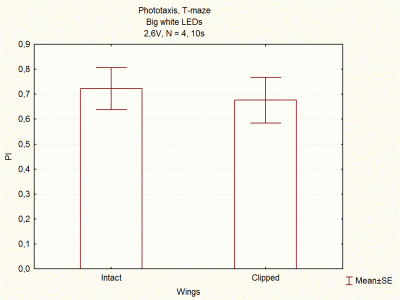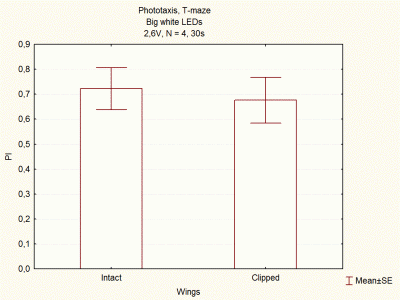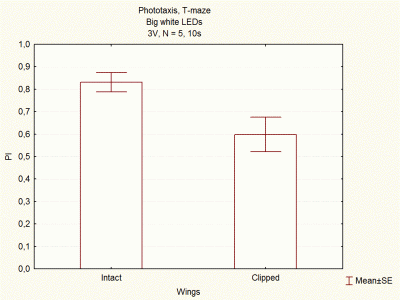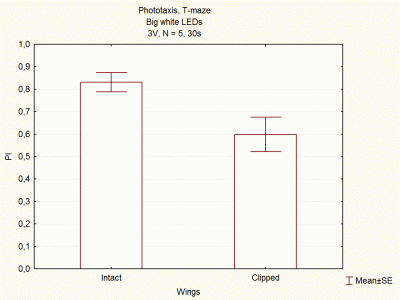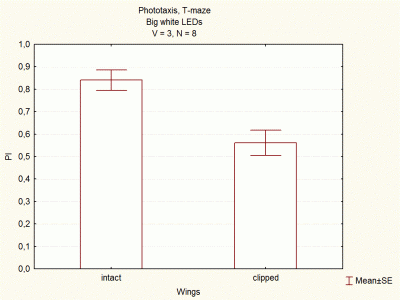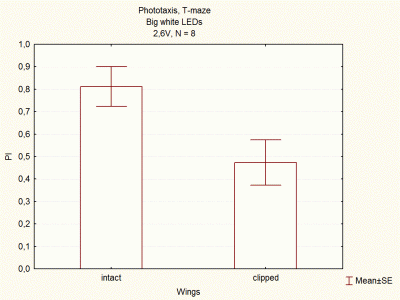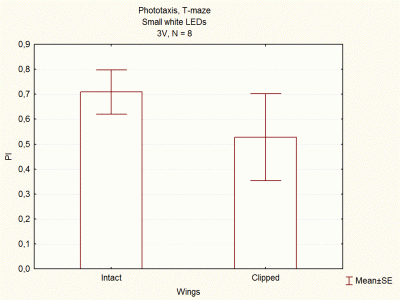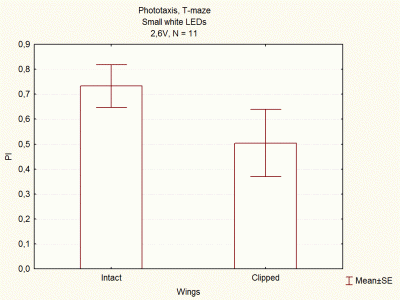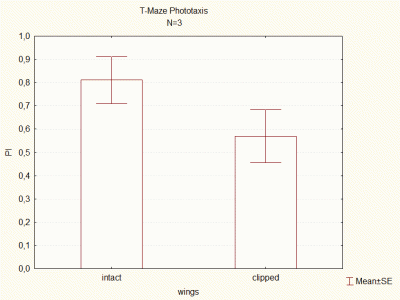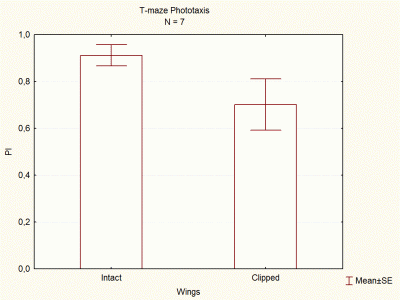New experiments: transparent T-maze
I have started doing experiments with the transparent T-maze, but I have some problems. The results are really weird: I have obtained negative phototaxis for both flies with intact and clipped wings (phototaxis is more negative for flies with intact wings????).
I did only 9 experiments, because I don’t really know how to run them and I need advice. I am going to explain how I was doing this experiments until now:
– First of all, I put the flies in the entrance tube of the T-maze (upper part) and I cover the T-maze with a black clothing (I want the flies to be adapted to the darkness, like in my last experiments with the opaque T-maze). They are in this situation for 10min.
– After that I push the flies into the elevator. I don’t know if I should let them stay there for 1 minute (like I was doing before with the opaque T-maze, or push them to the bottom of the T-maze to let them make their decision between darkness or light without an adaptation time.
I think that if they stay in the elevator for 1 minute, they will be again under light conditions, and that’s not good for the experiment. I could cover again the T-maze with the black clothing during this minute (that’s what I was doing until now, but with bad results).
– Then I let the flies decide for 30 seconds as always.
So if you have any suggestions, I will be glad to hear them :)
New experiments
I was trying to increase the differences between flies with clipped and intact wings, putting a paper covering the LEDs.
Results are not as good as I expected. The differences are lower than experiments done without this paper between LEDs and flies. I did experiments only with the big white LEDs (the ones which showed better results).
Comparison between voltages and size of white LEDs
I continued doing experiments with big and small white LEDs, and now I think I have done enough experiments to compare them.
These are the final results, which seem to indicate that big white LEDs using 2,6V are the best ones to continue with the experiments.
New phototaxis results
I am trying to find which are the best LEDs and voltages to do the phototaxis experiments.
For that, I was doing experiments with big and small white LEDs (the big ones are much more brighter than the other ones), and with two different voltages: 2,6V and 3V.
This are the results that I have obtained:
As we can see in the pictures, the best results are obtained when we use a voltage of 2,6, and for now big LEDs seem to be better than the smaller ones (we find more differences between flies with clipped wings and flies with intact wings).
But the number of experiments I have done are still not enough to make a good comparison between LEDs size and voltage.
Experiments with white LEDs
The first picture shows the experimental results obtained with the first white LEDs I have used (using a voltage of 3.0V).
The second one shows the experimental results obtained with the new white LEDs I am using this week (2.6 V).
The first ones are bigger than the second ones, and they are also much more brighter.
We can see in both graphs that there are some differences between flies with intact and clipped wings, being the ones with clipped wings less phototrophic than the others.
For now, graphics do not tell us almost anything about differences between both LEDs.
2nd Experiment
Yesterday, we cut the wings of half of the experimental flies.
We let them get over for 2 hours, and after that I repeated the same experiment we did last day, letting them choose between darkness and light.
There wasn’t a big difference between flies with wings and flies without wings, but the experiment shows flies without wings have less light preference than the other ones.
First T-maze experiment
Today, I started the experiment with 3 day-old flies.
We found out that they are responding as we thought they were going to do.
There was a white LED in one side of the T-maze, and darkness on the other side.
I run the experiment for 20 seconds, letting them choose between these two conditions. After counting them, I had these results:
82 flies were in the bright side, and 20 were in the dark side.
Tomorrow we will do the same experiment after cutting flies wings, and also we are going to try different LEDs.

